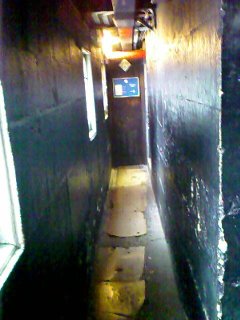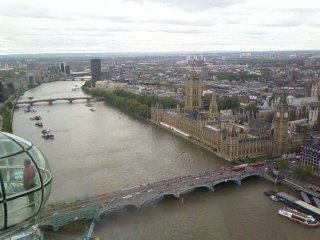 Getting to Gatwick turns out to be flawlessly timed this morning, even though it involves several transfers: out of the hostel at six to the Oxford Circus tube, step onto an arriving train, wait one minute for the Victoria tube, walk onto the waiting Gatwick train, and leave within half a minute.
Getting to Gatwick turns out to be flawlessly timed this morning, even though it involves several transfers: out of the hostel at six to the Oxford Circus tube, step onto an arriving train, wait one minute for the Victoria tube, walk onto the waiting Gatwick train, and leave within half a minute.I disembark forty-five minutes later at Gatwick thinking, That the rest of the trip to Seattle goes so smoothly.
Not quite.
Gatwick is wall-to-wall people. A harried airport worker points me to Zone B—farthest from the train’s entrance, but solely Continental—and I position myself in a single lane of people who are all pressing forward through seven lanes of oncoming travelers. Tempers are ragged, but most people shuffle along the best they can, looking haggard and travel-worn.
A few folks mutter and grumble and try to shove us up from behind as if we are a herd of recalcitrant cattle, but our progress is often blocked by cross-traffic: overpacked luggage trolleys, overflowing strollers, rolling hip-high suitcases, and enormous backpacks trailing their straps on the ground. Getting anywhere takes the stamina of a salmon swimming upstream for its last chance to spawn.
Having paid extra on my mileage card to upgrade to Business Elite class continues to pay off in valuable perks, especially on days when security remains high and the rest of humanity here is milling around in near-mob conditions. Zone B is in a basement of sorts, with Business Elite in their own check-in area. In the half hour wait, a man checks my papers while I’m in line, the lady takes my bag, checks me in, and sends me round the back end of the entry to the departure gates, which gets me to a security station in less than ten minutes.
They hand-search my daypack carry-on (which has very little in it), and are just about to take away my pens when, mid-search, the ban on pens is lifted—right after the security gal had to abscond with innumerable colored pens and pencils from a little girl’s pack ahead of me. I get to keep my pens, but she removes my aspirin, jetlag pills, apple, Snickers bar, and fruit granola bar before letting me through. Just about all that’s left is Perry, my writing tools, and my tickets/ID.
Sheesh. Talk about an unbalanced reaction to a threat. As of this morning, they’re now allowing cell phones, electronics, and laptop computers, all of which have detonation-capable battery systems, but they take away my Snickers bar. I feel so much safer.
Business Elite also means I have access to a Continental lounge, where I can while away the couple of hours until my flight. (Just for the record, the first class BritRail pass wasn’t worth the extra cost, even at summer travel, although the roomier carriages were more comfortable than in standard, and I sometimes had electrical power for Perry. About half of the trains I took didn’t offer first class. I was also more likely to talk to folks in standard than first, and I experienced more of the local people there.)
For the very bored (me right now) or the very desperate (god forbid I reach that point), Gatwick airport offers two floors of food and shopping and a smoking cell in the middle of the upper floor. The cell is about twenty by thirty feet, walled, unceilinged, with glass that curves inward over the smokers from shoulder height to six or seven feet up. An entrance is on each side of the cell. The space is packed—standing room only. Puff puff. Segregation of health. The opposite of an iron lung. A haze stands over the cell—that’s what caught my attention first: indoor smog.
Finally I’m on the plane. Tears come as I think of leaving Britain—I’m finally going back to the place I call home. I toast the event with a champagne mimosa while the plane continues to board. Christina is our attendant today. A charming black girl with friendly eyes and smile.
Business Elite feeds you. Seven course meal—warm nuts, bread and appetizer, salad, dinner, cheese/fruit plate, dessert, after-dinner drink. The 18-year-old boy next to me from New Jersey goes through five dinner rolls. I counted. He keeps asking for another one from different servers. Then more courses kept coming. He and his older brother have just spent five weeks in Greece, where this fellow was born. He goes every year. Their mom works for Continental; the eldest boy gets the travel perks, which he shared with his brother this trip. They swapped coach and business class on the way over; now it’s the younger boy’s turn to be in the plush seat. He’s loving it.
Mealtime over, he disappears into a movie, and I disappear into remembering my last day in London. Sitting by myself at St Paul’s steps yesterday, I took in the world, watching the people, and felt the truth of it all—the whole Earth is my home, these people—all of them—are my family, the same as I, different, all here sharing this time with each other, together.
What rooms will I go to next? Who will I meet next? When and where will I hook up with that life partner for good? How long am I to travel this planet’s halls, watching, sharing, experiencing, gathering Self knowledge?
Once we reach the US, it takes me longer to get through Newark airport than it did to get out of Gatwick and London. Wait for my baggage to come down the carousel, and then wait again to go through customs. Customs is so backed up because of heightened security that they make me leave my bag with them for a full search when they can get to it. I have a four-hour layover. The way to the lounge is convoluted and requires two security checks. Plus another security check to reach my actual gate for Alaska Airlines. Everywhere, security is understaffed.
I’m starting to feel tired, despite the “gain” of five hours’ time. It will be good to arrive at night and be able to go to sleep.
If we can ever get off the damn ground. First our plane arrives late from another destination, then it has an electrical failure after we’ve pulled away from the gate. We wait a half hour for an electrician, another half hour for him to declare the problem isn’t serious, then another hour to return to the jetway and crawl to our turn at the head of the runway. We finally are in the air three hours after our original departure time. I like Alaska Airlines. I really do. Just not at Newark Airport.
Even with a post-midnight arrival in Seattle, with SeaTac airport shut down and empty, my friend Patti and her daughter, bless them, are waiting for me. I collect my checked bag (grateful and astonished that it actually got here), and they drive me the 60 or so miles to Olympia in the wee hours of the morning.
I manage to stay awake enough to visit with my housemate, Marianne, who also has waited up for me to come home at 2am. Most important, I have a happy reunion with Patchouli, my cat, who, to my great surprise, does not give me a cold shoulder for having left him for the summer, but instead climbs all over me, purring his happy little heart out. Marianne has taken good care of him.
Leaving the job of unpacking for later (like five days from now), I collapse into bed and curl up into warm and familiar surroundings. It’s good to be home. Processing the trip, like washing the clothes, can wait.






















 Instead, I walked from Westminster to Kensington via the south edge of St James Park, round Buckingham Palace along Constitution road, then through back-neighborhood roads and mews west of the Buck House. I came upon and meandered through Harrods a bit (the four floors of Egyptian-décor elevators are like something out of a Disneyland ride). Tired feet encouraged me to Tube back to the hotel.
Instead, I walked from Westminster to Kensington via the south edge of St James Park, round Buckingham Palace along Constitution road, then through back-neighborhood roads and mews west of the Buck House. I came upon and meandered through Harrods a bit (the four floors of Egyptian-décor elevators are like something out of a Disneyland ride). Tired feet encouraged me to Tube back to the hotel.


